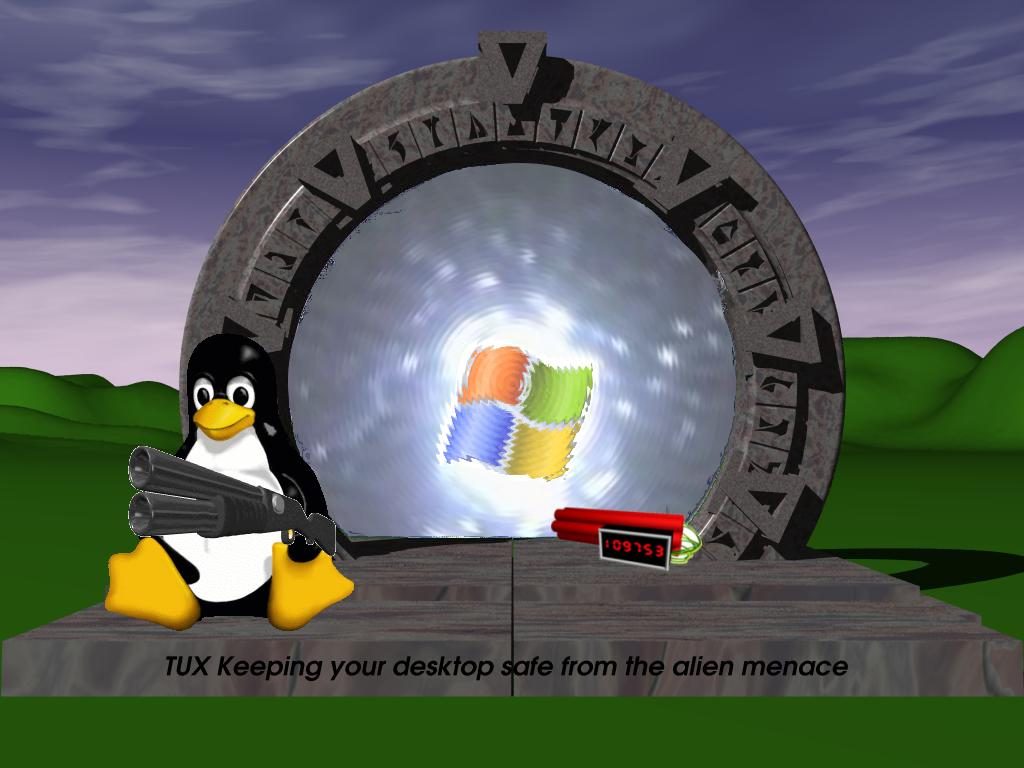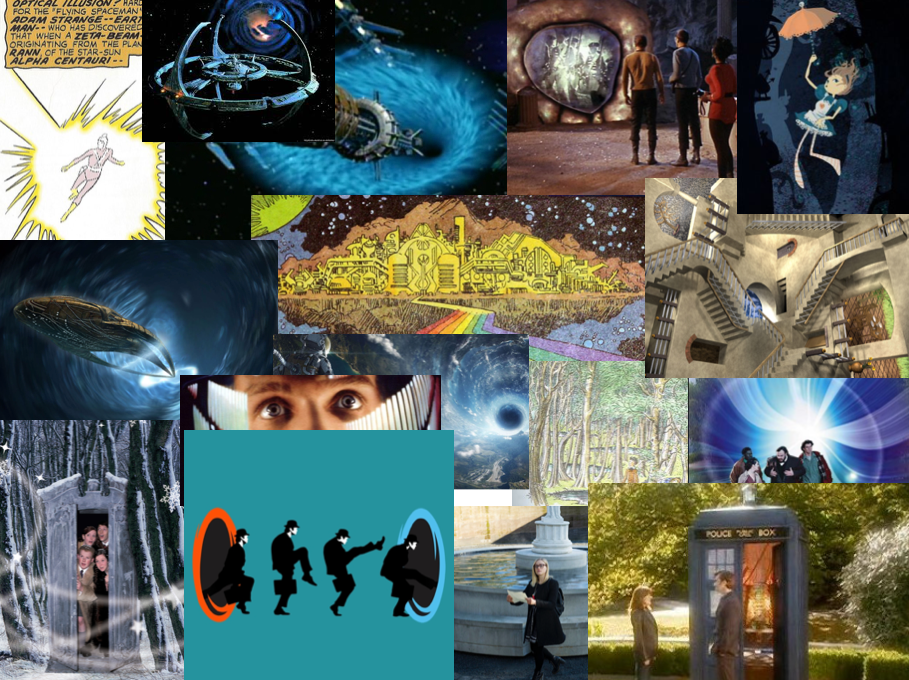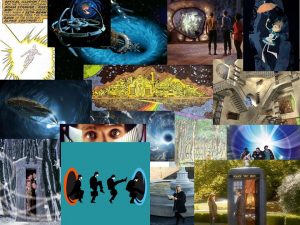
Linux & Stargates
The talk has been rescheduled: it is now April 4th, 2018, same place: University of the Sciences, same time: 7pm.
Some new stuff: thanks to the 7th observation of a gravitational wave, the speed of gravitational waves is now known to be the speed of light. And researchers have built a carillion using black hole frequencies as the pipes.
I’ll be doing my StarGates talk at the Philadelphia Linux meeting at the University of the Sciences this coming Wednesday.
Why StarGates & Linux?
- Both are really cool.
- Both take us to the limits of the possible.
- And both let us push the limits of the possible another half-step beyond where it is.
As to #1, if you are reading this the odds are you are already current with the cool of each.
And #2 goes without saying: Linux is an amazing work, putting the most powerful general purpose operating system in the hands of the open source community, in the hands of the world.
But #3 — extending the limits of the possible — is what I will be focusing on in my presentation: by asking questions about the impossible, we can extend the reach of the possible: get our grasp a bit closer to our reach, as the saying goes.
So March 7th, at the University of the Sciences in Philadelphia, at 8pm, great if you can make it, and if not, have your imagination hop over & have a look.
To infinity and beyond!
Tux & StarGates from Linux-Lovers

9/3/2017: I have just posted the slides from Fosscon on slideshare. Comments, questions, problems, & buildable blueprints, all very welcome!
This coming Saturday I’ll be doing the latest revision of my StarGates talk at FossCon, the Free & Open StarS Convention!
(Pay no attention to those who assert this is the Free & Open Source Convention, that is a mere cover story.)
The convention is at International House in Philadelphia, starting at 9am, and is free. As to my talk:
“Call them Stargates, Jumpgates, Fargates, Hypergates or just an invitation to every pest from the far reaches of the Galaxy to visit, they would be invaluable in helping mankind break free of this solar system.
Are StarGates only a convenient plot device — or could they actually be built? Accordingly to Einstein’s Theory of General Relavity, they are possible — at least in principle.
We will discuss how to glue black holes together to build a wormhole, how to avoid the dangers of spaghettification, radiation poisoning and paradox noise, and just what would it take to build one in practice.”
My talk’s at 1pm. Hope to see you there!
And there I have you seen! There was a nice turnout (in the South America room at International House) with a lot of questions. We finished with a few minutes for additional questions, including my favorites:
What happens if you drag a wormhole through a wormhole?
I congratulated the questioner on the question & he just pointed at his young son sitting next, a lad clearly with a bright future as a scientist!
I had to admit I wasn’t sure, but I suspect it would be bad news for all concerned: both wormholes, and any spaceships, space stations, or space-persons nearby!
How do you think this might actually be done?
I focused on wormholes because that is far & away the most popular of the approaches. But if some sort of stargate were ever actually to come to fruition, I suspect a combination of the Einstein-Rosen-Podolsky (EPR) effect and the ideas behind the Krasnikov tube would be at work. The EPR effect is the spooky-action-at-a-distance Einstein objected to; the Krasnikov tube is an idea of — curiously enough — Krasnikov for laying out a tube of warped spacetime behind your slower-than-light spacecraft. You’d have to go slower-than-light while laying out the tube, but could use it for faster-than-light thereafter. And as I said in the talk, negative energy & vortices are pretty sure to be involved.

Beware of Unexpected Doors!
Call them Stargates, Jumpgates, Fargates, Hypergates or just an invitation to every unwanted pest from the far reaches of the Galaxy to visit, they are absolutely necessary if we are to have the glorious Science Fiction action we desperately need. Could they actually be built? Modern physics may permit, but: how to glue black holes together to build a wormhole, how to avoid the dangers of spaghettification, radiation poisoning and paradox noise, and just what would it take to build one in practice?
I’ve just finished revising my StarGates — the theory & practice — for Balticon. It’s a Good News/Bad News thing: Bad News: we don’t know how to build them, Good News: we can’t prove we can’t, someday!
Slides for talk now up on SlideShare; comments & questions very welcome.
Talk will be this coming Saturday, May 27, 9am at Balticon. If in the neighborhood, drop by. If not in the neighborhood, spin up a stargate & jump in!
I’ll be doing my talk “Quantum Mechanics, Reality, & You” tomorrow at Capclave, the DC SF Convention. I have the latest slides up on slideshare.
Enjoyed putting the talk together. I go thru the interpretations of quantum mechanics — some spectacularly silly — and then argue that quantum mechanics is real, you & I — not so much. 🙂
Also doing panels at Capclave on Hot Steamed Punk, Practical Uses of Faster-Than-Light Travel, Choose Your Own Apocalypse, & Great Cthulhu: Threat or Menace?
I’ve uploaded a number of my more recent talks to Slideshare. Physics, with occasionally a wee bit of speculation admixed:
- Thought experiments – talk done 1st April 2012 for the Ben Franklin Thinking Society. Role of thought experiments in history, use by Galileo & by noted violinist, how they can turn into real experiments.
- Not Your Grandfather’s Gravity – done last year (2011) on the latest developments in the suddenly hot area of gravity. The stuff on faster-than-light neutrinos is, alas, already out of date: boring won: looks as if the FTL neutrinos were due to experimental error. But Verlinde’s entropic gravity is still one of the most promising lines of attack.
- Temporal Paradoxes – physics talk given at NASA’s Goddard Space Center 2011. A slightly NASA-fied version of a talk I’d given at several SF conventions in 2010.
- Quantum time – physics talk given at Feynman Festival in Olomouc in 2009. I did popular versions of that talk as well.
- How to build a (real) time machine – talk given at several SF conventions in 2009.
- Life, the Universe, & the Second Law of Thermodynamics. Or, the Infinite Probability drive. About the role of entropy in the universe, complete with Babelfish. 2008.
- Faster Than Light – talk on faster than light travel: theory, practice, applications. Given at several SF conventions in 2007.
- Confused at a Higher Level – arguably one of the funniest talks ever given about problems in quantum mechanics. OK, competition not that fierce. Given at several SF conventions in 2004.
- The Physics of Time Travel. Review of time, with respect to the bending, stretching, folding, & tormenting thereof. Given at Philcon & Balticon (in various versions) in 2003.
- The Future of Time Travel – mostly about the science fiction thereof. Probably 2002.
These are not all of my talks — I’ve probably done 20 or 30 SF talks over the last 20 years, at least one per year — these are just the ones done using Keynote or Powerpoint. The 2005 & 2006 talks have gone walkabout. If they reappear, I will upload. I generally talk at Balticon, Philcon, & more recently Capclave. I’ve spoken twice at Farpoint, but that is really more of a media convention, not as good a fit.
Talks before 2002 were done with Word & overheads. Overheads are easier to make than slides, but have a tendency to get bent, flipped, out of order, or in one especially memorable talk: burnt. That talk I was doing at the Franklin Inn Club: the projector failed at the last minute & I had to rent another from a nearby camera shop. The rented projector ran hot. If I stayed on a specific slide for more than 60 seconds, the slide began to smoke. Literally. Colored smoke of course, wafting in strange tendrils towards the ceiling. Taught me a lot about pacing, mostly to make it faster.
By the way the word you are looking for, in re me & time travel, is not obsessed, it is focused. Let’s just be clear about that.
Other talk(s), marginally less speculative:
- Overview of Backbone – talk on the jQuery library Backbone, given at PhillyCoders. April 2012.
- How to Destroy a Database – talk on database security. October 2007. Wile E. Coyote & other experts on correctness & security are enlisted to help make key points.
- Getting started with MySQL – talk given at PACS and my Macintosh programming group in 2006. Manages to work in the Sumerians, the Three Stooges, a rocket-powered daschhund, some unicorns, and – of course – dolphins (the totem animal of MySQL).
 Announcement, Faster than LIght, Interpretations of Quantum Mechanics, Popular, Quantum Gravity, Quantum Mechanics, Quantum Time, Science Fiction, Time, Time Machines | John Ashmead |
Announcement, Faster than LIght, Interpretations of Quantum Mechanics, Popular, Quantum Gravity, Quantum Mechanics, Quantum Time, Science Fiction, Time, Time Machines | John Ashmead |  May 21, 2012 8:10 pm |
May 21, 2012 8:10 pm |  Comments Off on Talks now on Slideshare
Comments Off on Talks now on Slideshare
I’m on the Space War panel at Balticon, how & why. Fun topic though in all candor, a bit implausible.
The main problem is that travel in space is likely to be slow, expensive, & a bit dangerous. Given this, it is likely that space travel itself will be reserved for moving stuff that is light weight & of very high value: information, pharmaceuticals, experts, embryos, the “unobtainium” that features in Avatar, and so on. Bullets satisfy neither test & even nukes have a hard time.
And if it takes a century to get over to the enemy’s star, why bother having the war? And what are you fighting about anyway? To have a war you have to be close enough to do some damage in a reasonable time frame & similar enough to have common — if opposed — objectives.
I owe the initial observation about the high costs of space travel to Paul Krugman, the Nobel-prize winning economist. In the spirit of not pointing out problems without also pointing out a solution, he has found an economically viable use for space war: as a way to generating a badly-needed stimulus, a kind of weaponized Keynesianism.
Given that there is now new hope for space war, and to get me in the right frame of mind for the panel, I list ten of my favorite space war novels:
- The War of the Worlds by H. G. Wells. The number one space war novel. The evil octopi are defeated by our germs. Great idea; two problems: 1) germs have to co-evolve to be effective against a host; ours probably would have no effect on the Martians and 2) real octopi are fun: they play pranks on their experimenters & are great communicators as well. With their ability to change skin color at will, octopi are practically eight-tentacled color television sets.
- The Lensman series by E. E. “Doc” Smith. Six deathless volumes, each with at least two space-shaking interstellar battles. Chlorine breathers beware! The oxygen breathers of the galaxy have found your secret base & are going to reduce it to a glowing pile of molten rock.
- Which is pretty much what happens to the lunar military base in Arthur Clarke‘s Earthlight. Three Federation cruisers duel it out to a jointly fatal draw with a lunar fortress. The war is about mineral rights & induced by attacks of mutually assured dementia, making the physics (this is Arthur C. Clarke!), the war, & the politics pretty realistic.
- Starship Troopers by Robert Heinlein. Heinlein wrote about space suits in his pre-WWII SF, then used ideas from his stories when helping to design pressure suits for our fighter pilots in WWII, then used ideas from those pressure suits for his Have Spacesuit, Will Travel juvenile and for Starship Troopers: a beautiful example of the inter-relationship of reality & SF. The space combats are a bit less stupid than most; Heinlein understands something of the difficulty of taking a space war to an underground enemy.
- The Forever War by Joe Haldeman. This is partly a reaction to the Vietnam War & partly a reaction against Starship Troopers. The forever war starts by accident, proceeds by error, and lasts for over a thousand years: both humans & aliens are restricted to sub-light travel, so the war plays out in slow motion. One of the few successful space war stories that works with existing physics.
- Keith Laumer’s Bolo Series. Laumer wrote a long series of stories about Bolos, giant sentient tanks that are every adolescent male’s dream weapon. In practice, they would likely be an economic & military disaster: witness some of the late stage Nazi vehicles: mechanically problematic, too heavy for bridges, & absorbing a disproportionate share of the military budget. See Arthur Clarke’s delightful story Superiority.
- Dan Simmon‘s Hyperion series, especially the 2nd volume, The Fall of Hyperion, which concludes with a beautifully realized space battle between two fleets for control of a planetary system. The inevitable confusion & long delays of such a battle are foregrounded.
- Catherine Asaro‘s Skolian Empire series. Asaro has a physics background, gets existing physics right, & invents as much as she needs to keep the action fast-moving & interstellar. The space combats are realistic: long periods of nothing, brief high velocity exchanges of fire & then more long pauses while the surviving opponents regroup & turn around. They remind me of the lance combats in White’s The Once & Future King.
- David Weber’s Honorverse series, starting with Manticore Station. Weber is another author who tries to “get it right”. The politics are modeled on the dueling ship combats of the Napoleonic wars, with wormholes to get realtime star to star travel without invoking faster-than-light mechanics (which would imply time-travel & a lot of confusion: it is very rough on a space navy to first have triumphantly triumphed & then never to have been in the first place!). He sets up the physics & weapons so that the ships even have broadsides, includes relativistic time dilation, and so on. Weber’s Honor Harrington owes her “H’s” and general command style to C. S. Forester‘s Horatio Hornblower. In a video game version of the Honorverse, it turned out that realistic implementing the physics/combat implied a near-planet maneuver (wish I could remember what it was) that invalided much of the combat in the novels. With the infinite authority of the auteur, Weber passed a treaty that banned the disastrous trick.
- And I’ll finish with John G. Henry‘s Lost Fleet series. The first six volumes reset Xenophon’s Anabasis in a medium-future space-faring context, again with wormholes connecting selected star systems. A nearly destroyed fleet has to work its way back home in the face of enemy attack, mutiny, and sheer running out of resources. Henry’s focuses on the many conflicting pressures on his commander, Jack Geary, as Geary balances military requirements, the demands of honor, & the imperatives of law, democracy, and a forbidden love. The space combat — Henry used to be a ship driver in the US Navy – takes place in four dimensions and with admirable clarity about the command difficulties created by the finite speed of light: if the enemy is on the far side of a solar system, he will see your maneuver only hours after you make it — and you will see his response hours after that. You have to factor his response — and the responses of your detached units — into every move you make. It is like blindfolded chess where you don’t find out the enemy’s move until after you have made three more moves of your own. And your pieces are moving on their own.
And a couple of titles to avoid:
- Anything by C. J. Cherryh, as least as far as space combat goes. I remember reading one of her novels where the defenders had an advantage because they were at rest. In space, both sides are at rest with respect to themselves; the comment & resulting tactics were just nonsense. Nonsense on stilts.
- Gordon Dickson’s Dorsai series. Omni-competent genetically enhanced uber soldiers trash lots of stooges. The “ho” meets the “hum”.
So, my minimal requirement for space war in science fiction(not counting the golden classics of one’s youth of course) is that the humans, the physics, & the space war should make at least a bit of sense.

